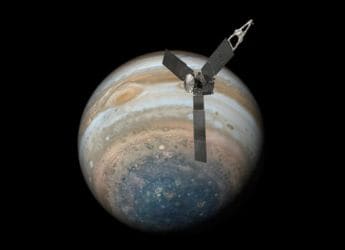- Home
- Science
- Science News
- Perseverance Spots Possible Interstellar Comet 3I/ATLAS Over Martian Sky
Perseverance Spots Possible Interstellar Comet 3I/ATLAS Over Martian Sky
NASA’s Perseverance rover captured a glowing streak above Mars, possibly interstellar comet 3I/ATLAS.

Photo Credit: NASA
Perseverance spots mysterious streak—possibly interstellar comet 3I/ATLAS
On October 4, 2025, the NASA Perseverance rover on Mars captured a curious streak of light in its Navcam image during a period when an interstellar comet, 3I/ATLAS, was predicted to pass by Mars. Was this thin line really some object that was born outside our solar system and was momentarily visible as we looked out on the surface of Mars? Scientists are even arguing whether Perseverance may have captured one of the rare astronomical spectacles, namely, an interstellar comet flying over a desolate alien planet.
Glow Above the Red Planet
According to the Navcam image, the thin streak traced across the martian sky at a time and alignment consistent with 3I/ATLAS's predicted flyby. Although the picture is a single image, scientists believe that it could be more effective to combine several frames and prove that there is motion, similar to a high-speed comet. Nonetheless, other explanations are possible; the streak may be a result of an asteroid in the background or the moon Phobos passing over the frame. Currently, no conclusive evidence exists, although the time and the direction are similar enough to make the prospect hard to ignore.
Why 3I/ATLAS Matters
Comet 3I/ATLAS (discovered on July 1, 2025, by the ATLAS survey in Chile) has a hyperbolic and unbound orbit. It will approach Mars by about 0.193 AU on October 3, and then firmly approach the Sun and leave the solar system. The speed (more than 130,000 mph) and strange alignment suggest that it was formed in the thick disk of the Milky Way. As one of the few interstellar visitors we can observe closely, it offers a rare chance to analyze the building blocks of other star systems, compare isotopes, and test ideas about how comets are ejected into the galaxy.
For the latest tech news and reviews, follow Gadgets 360 on X, Facebook, WhatsApp, Threads and Google News. For the latest videos on gadgets and tech, subscribe to our YouTube channel. If you want to know everything about top influencers, follow our in-house Who'sThat360 on Instagram and YouTube.
Related Stories
- Samsung Galaxy Unpacked 2025
- ChatGPT
- Redmi Note 14 Pro+
- iPhone 16
- Apple Vision Pro
- Oneplus 12
- OnePlus Nord CE 3 Lite 5G
- iPhone 13
- Xiaomi 14 Pro
- Oppo Find N3
- Tecno Spark Go (2023)
- Realme V30
- Best Phones Under 25000
- Samsung Galaxy S24 Series
- Cryptocurrency
- iQoo 12
- Samsung Galaxy S24 Ultra
- Giottus
- Samsung Galaxy Z Flip 5
- Apple 'Scary Fast'
- Housefull 5
- GoPro Hero 12 Black Review
- Invincible Season 2
- JioGlass
- HD Ready TV
- Laptop Under 50000
- Smartwatch Under 10000
- Latest Mobile Phones
- Compare Phones
- HMD Touch 4G
- Vivo V60e
- Lava Bold N1 Lite
- Samsung Galaxy F07
- Realme 15x 5G
- OPPO A6 5G
- Samsung Galaxy M07
- Xiaomi 17
- Asus Vivobook S16 (S3607QA)
- Gigabyte AORUS Master 16
- Samsung Galaxy Tab A11+
- Xiaomi Pad 8
- Xiaomi Smart Band 10 Glimmer Edition
- Xiaomi Watch S4 41mm
- Xiaomi Xiaomi TV S Pro Mini LED 55 2026
- Xiaomi TV S Pro Mini LED 65 2026
- Asus ROG Ally
- Nintendo Switch Lite
- Haier 1.6 Ton 5 Star Inverter Split AC (HSU19G-MZAID5BN-INV)
- Haier 1.6 Ton 5 Star Inverter Split AC (HSU19G-MZAIM5BN-INV)

















